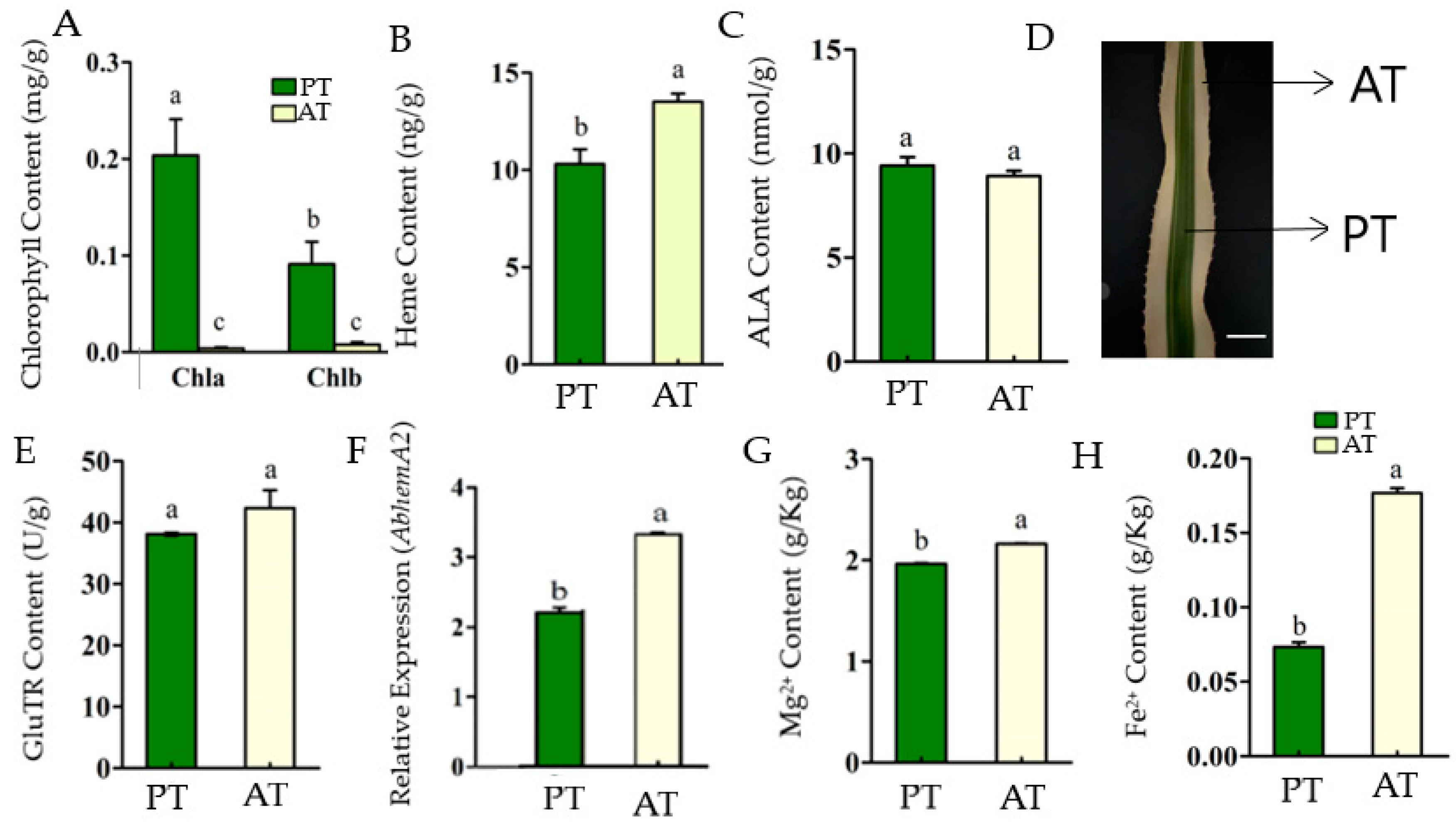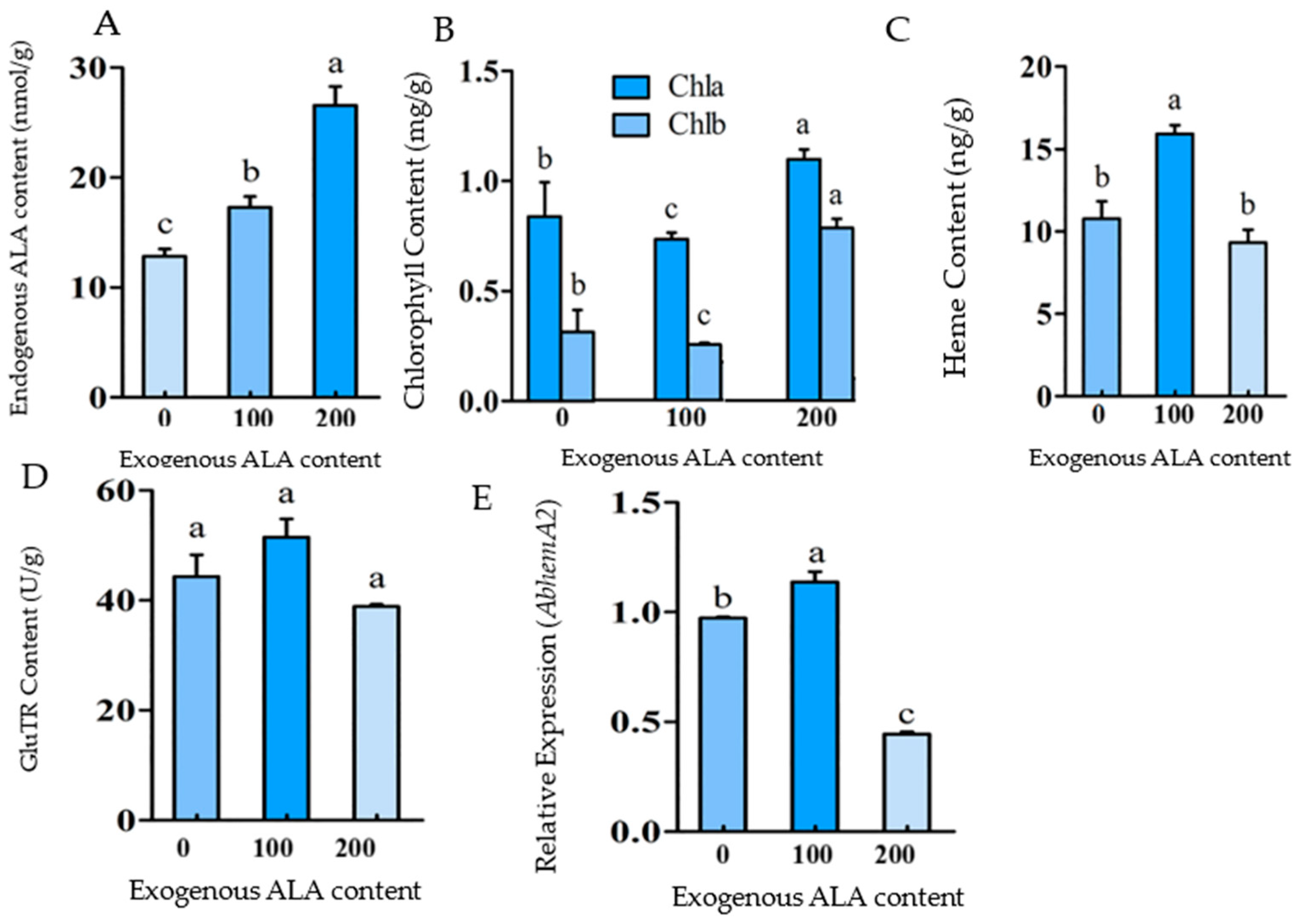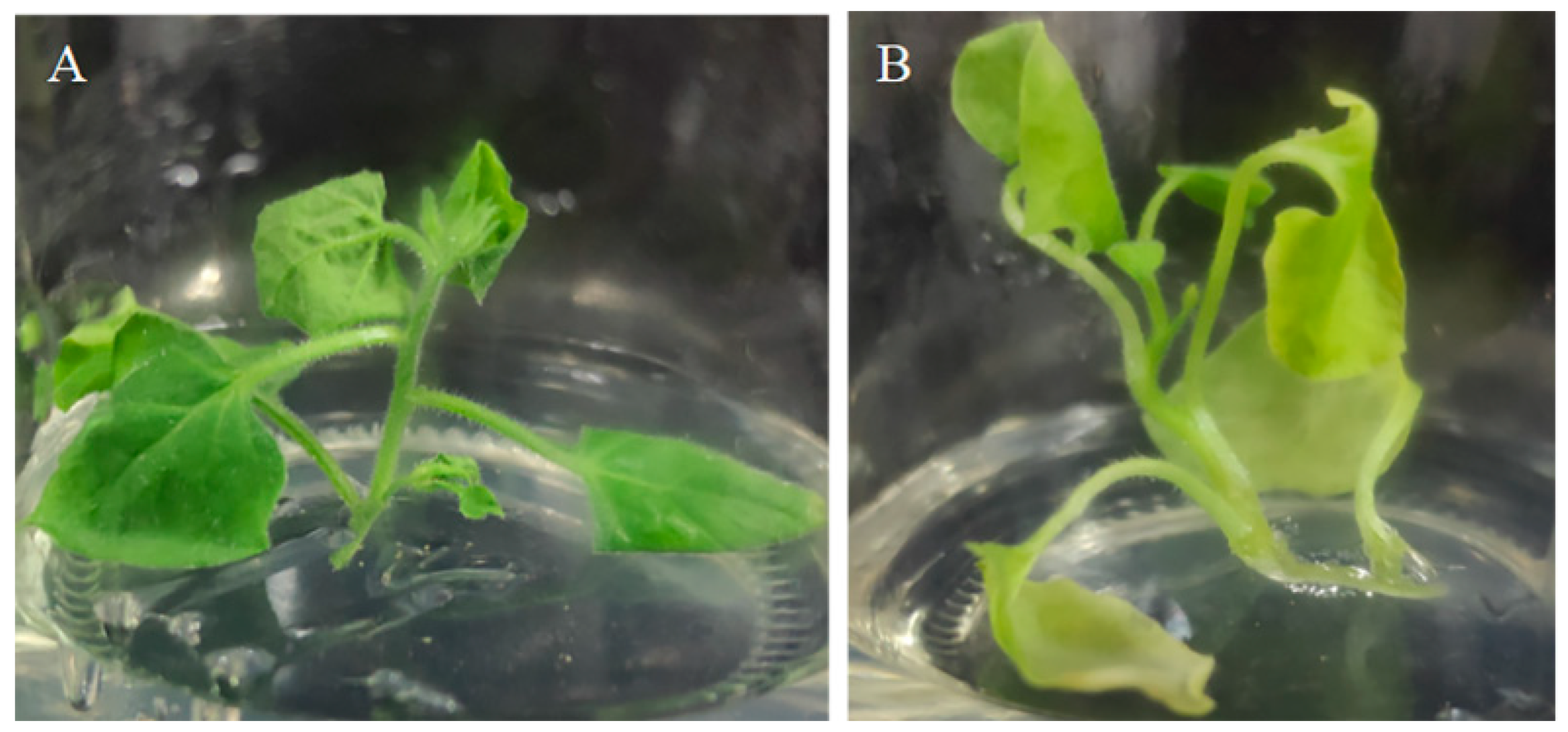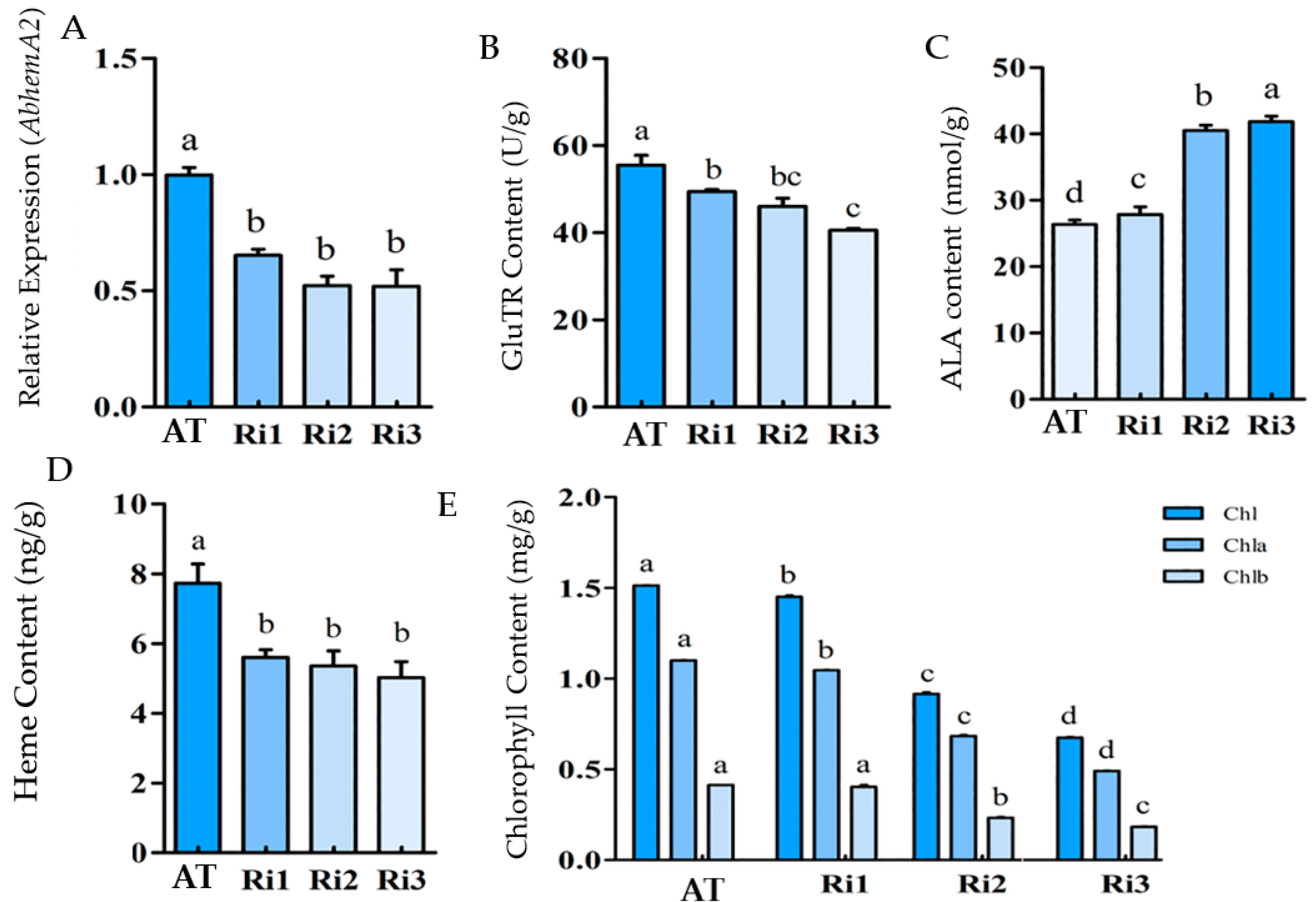Function of ALA Content in Porphyrin Metabolism Regulation of Ananas comosus var. bracteatus
Abstract
1. Introduction
2. Results
2.1. Porphyrin Metabolism Characters in Chimeric Leaves
2.2. Effects of Exogenous ALA Supplementation on Porphyrin Metabolism
2.3. Effects of HemA Expression on Porphyllrin Metabolism
3. Discussion
4. Materials and Methods
4.1. Plant Material
4.2. Determination of Photosynthetic Pigments
4.3. Determination of ALA Content
4.4. Determination of Heme Content
4.5. Determination of Mg2+ and Fe2+ Content
4.6. Determination of GluTR Content
4.7. Supply of Exogenous ALA
4.8. Expression Interference of hemA Gene
4.9. Data Analysis
5. Conclusions
Supplementary Materials
Author Contributions
Funding
Institutional Review Board Statement
Informed Consent Statement
Data Availability Statement
Acknowledgments
Conflicts of Interest
References
- Vincent, L.; Anushma, P.; Vasugi, C.; Rekha, A.; Shiva, B. Genetic Resources of Tropical Fruits. In Conservation and Utilization of Horticultural Genetic Resources; Springer: Berlin/Heidelberg, Germany, 2019; pp. 79–116. [Google Scholar]
- Ogata, T.; Yamanaka, S.; Shoda, M.; Urasaki, N.; Yamamoto, T. Current status of tropical fruit breeding and genetics for three tropical fruit species cultivated in Japan: Pineapple, mango, and papaya. Breed. Sci. 2016, 66, 69–81. [Google Scholar] [CrossRef]
- Zhou, X.; Xue, Y.; Mao, M.; He, Y.; Adjei, M.O.; Yang, W.; Hu, H.; Liu, J.; Feng, L.; Zhang, H. Metabolome and transcriptome profiling reveals anthocyanin contents and anthocyanin-related genes of chimeric leaves in Ananas comosus var. bracteatus. BMC Genom. 2021, 22, 331. [Google Scholar] [CrossRef] [PubMed]
- Li, X.; Kanakala, S.; He, Y.; Zhong, X.; Yu, S.; Li, R.; Sun, L.; Ma, J. Physiological characterization and comparative transcriptome analysis of white and green leaves of Ananas comosus var. bracteatus. PLoS ONE 2017, 12, e0169838. [Google Scholar] [CrossRef] [PubMed]
- Mao, M.; Xue, Y.; He, Y.; Zhou, X.; Rafique, F.; Hu, H.; Liu, J.; Feng, L.; Yang, W.; Li, X. Systematic identification and comparative analysis of lysine succinylation between the green and white parts of chimeric leaves of Ananas comosus var. bracteatus . BMC Genom. 2020, 21, 383. [Google Scholar] [CrossRef]
- Phung, T.-H.; Jung, H.-i.; Park, J.-H.; Kim, J.-G.; Back, K.; Jung, S. Porphyrin biosynthesis control under water stress: Sustained porphyrin status correlates with drought tolerance in transgenic rice. Plant Physiol. 2011, 157, 1746–1764. [Google Scholar] [CrossRef] [PubMed]
- Zhang, Z.; Cui, Q.; Chen, L.; Zhu, X.; Zhao, S.; Duan, C.; Zhang, X.; Song, D.; Fang, L. A critical review of microplastics in the soil-plant system: Distribution, uptake, phytotoxicity and prevention. J. Hazard. Mater. 2022, 424, 127750. [Google Scholar] [CrossRef]
- Ma, W.; Yi, F.; Xiao, Y.; Yang, G.; Chen, F.; Wang, J. Isolation of leaf mesophyll protoplasts optimized by orthogonal design for transient gene expression in Catalpa bungei . Sci. Hortic. 2020, 274, 109684. [Google Scholar] [CrossRef]
- Zhao, C.; Wang, Y.; Chan, K.X.; Marchant, D.B.; Franks, P.J.; Randall, D.; Tee, E.E.; Chen, G.; Ramesh, S.; Phua, S.Y. Evolution of chloroplast retrograde signaling facilitates green plant adaptation to land. Proc. Natl. Acad. Sci. USA 2019, 116, 5015–5020. [Google Scholar] [CrossRef]
- Kapoor, D.; Singh, S.; Kumar, V.; Romero, R.; Prasad, R.; Singh, J. Antioxidant enzymes regulation in plants in reference to reactive oxygen species (ROS) and reactive nitrogen species (RNS). Plant Gene 2019, 19, 100182. [Google Scholar] [CrossRef]
- Zhang, Z.; Tan, J.; Shi, Z.; Xie, Q.; Xing, Y.; Liu, C.; Chen, Q.; Zhu, H.; Wang, J.; Zhang, J. Albino Leaf1 that encodes the sole octotricopeptide repeat protein is responsible for chloroplast development. Plant Physiol. 2016, 171, 1182–1191. [Google Scholar]
- Feng, J.; Shi, Q.; Wang, X.; Wei, M.; Yang, F.; Xu, H. Silicon supplementation ameliorated the inhibition of photosynthesis and nitrate metabolism by cadmium (Cd) toxicity in Cucumis sativus L. Sci. Hortic. 2010, 123, 521–530. [Google Scholar] [CrossRef]
- Zhao, M.-H.; Li, X.; Zhang, X.-X.; Zhang, H.; Zhao, X.-Y. Mutation mechanism of leaf color in plants: A review. Forests 2020, 11, 851. [Google Scholar] [CrossRef]
- Tripathy, B.C.; Pattanayak, G.K. Chlorophyll biosynthesis in higher plants. Photosynth. Plast. Biol. Energy Convers. Carbon Assim. 2012, 34, 63–94. [Google Scholar]
- Wu, Y.; Liao, W.; Dawuda, M.M.; Hu, L.; Yu, J. 5-Aminolevulinic acid (ALA) biosynthetic and metabolic pathways and its role in higher plants: A review. Plant Growth Regul. 2019, 87, 357–374. [Google Scholar] [CrossRef]
- Pham, N.-T.; Kim, J.-G.; Jung, S. Differential antioxidant responses and perturbed porphyrin biosynthesis after exposure to oxyfluorfen and methyl viologen in Oryza sativa . Int. J. Mol. Sci. 2015, 16, 16529–16544. [Google Scholar] [CrossRef]
- Willows, R.D. Biosynthesis of chlorophylls from protoporphyrin IX. Nat. Prod. Rep. 2003, 20, 327–341. [Google Scholar] [CrossRef]
- Velini, E.D.; Trindade, M.L.B.; Alves, E.; Catâneo, A.C.; Marino, C.L.; Maia, I.D.G.; Mori, E.S.; Furtado, E.L.; Guerrini, I.A.; Wilcken, C.F. Eucalyptus ESTs corresponding to the protoporphyrinogen IX oxidase enzyme related to the synthesis of heme, chlorophyll, and to the action of herbicides. Genet. Mol. Biol. 2005, 28, 548–554. [Google Scholar] [CrossRef]
- Zielewicz, W.; Wróbel, B.; Niedbała, G. Quantification of chlorophyll and carotene pigments content in mountain melick (Melica nutans L.) in relation to edaphic variables. Forests 2020, 11, 1197. [Google Scholar] [CrossRef]
- De Montellano, P.R.O.; Wilks, A. Heme oxygenase structure and mechanism. Adv. Inorg. Chem. 2000, 51, 359–407. [Google Scholar]
- Sanchini, A.; Grosjean, M. Quantification of chlorophyll a, chlorophyll b and pheopigments a in lake sediments through deconvolution of bulk UV–VIS absorption spectra. J. Paleolimnol. 2020, 64, 243–256. [Google Scholar] [CrossRef]
- Jahn, D.; Moser, J.; Schubert, W.-D.; Heinz, D.W. Transfer RNA-dependent aminolevulinic acid formation: Structure and function of glutamyl-tRNA synthetase, reductase and glutamate-1-semialdehyde-2, 1-aminomutase. In Chlorophylls and Bacteriochlorophylls; Springer: Berlin/Heidelberg, Germany, 2006; pp. 159–171. [Google Scholar]
- Zeng, Z.-Q.; Lin, T.-Z.; Zhao, J.-Y.; Zheng, T.-H.; Xu, L.-F.; Wang, Y.-H.; Liu, L.-L.; Jiang, L.; Chen, S.-H.; Wan, J.-M. OsHemA gene, encoding glutamyl-tRNA reductase (GluTR) is essential for chlorophyll biosynthesis in rice (Oryza sativa). J. Integr. Agric. 2020, 19, 612–623. [Google Scholar] [CrossRef]
- Papenbrock, J.; Pfündel, E.; Mock, H.P.; Grimm, B. Decreased and increased expression of the subunit CHL I diminishes Mg chelatase activity and reduces chlorophyll synthesis in transgenic tobacco plants. Plant J. 2000, 22, 155–164. [Google Scholar] [CrossRef] [PubMed]
- Jung, S.; Lee, H.-J.; Lee, Y.; Kang, K.; Kim, Y.S.; Grimm, B.; Back, K. Toxic tetrapyrrole accumulation in protoporphyrinogen IX oxidase-overexpressing transgenic rice plants. Plant Mol. Biol. 2008, 67, 535–546. [Google Scholar] [CrossRef]
- Ryberg, M.; Terry, M.J. Analysis of protochlorophyllide reaccumulation in the phytochrome chromophore-deficient aurea and yg-2 mutants of tomato by in vivo fluorescence spectroscopy. Photosynth. Res. 2002, 74, 195–203. [Google Scholar] [CrossRef] [PubMed]
- Richter, A.S.; Banse, C.; Grimm, B. The GluTR-binding protein is the heme-binding factor for feedback control of glutamyl-tRNA reductase. Elife 2019, 8, e46300. [Google Scholar] [CrossRef]
- Kumar, A.M.; Söll, D. Antisense HEMA1 RNA expression inhibits heme and chlorophyll biosynthesis in Arabidopsis . Plant Physiol. 2000, 122, 49–56. [Google Scholar] [CrossRef]
- Stolárik, T.; Hedtke, B.; Šantrůček, J.; Ilík, P.; Grimm, B.; Pavlovič, A. Transcriptional and post-translational control of chlorophyll biosynthesis by dark-operative protochlorophyllide oxidoreductase in Norway spruce. Photosynth. Res. 2017, 132, 165–179. [Google Scholar] [CrossRef]
- Wang, H.; Li, Z.; Yuan, L.; Zhou, H.; Hou, X.; Liu, T. Cold acclimation can specifically inhibit chlorophyll biosynthesis in young leaves of Pakchoi. BMC Plant Biol. 2021, 21, 172. [Google Scholar] [CrossRef]
- Nagai, S.; Koide, M.; Takahashi, S.; Kikuta, A.; Aono, M.; Sasaki-Sekimoto, Y.; Ohta, H.; Takamiya, K.-i.; Masuda, T. Induction of isoforms of tetrapyrrole biosynthetic enzymes, AtHEMA2 and AtFC1, under stress conditions and their physiological functions in Arabidopsis . Plant Physiol. 2007, 144, 1039–1051. [Google Scholar] [CrossRef]
- Hedtke, B.; Alawady, A.; Chen, S.; Börnke, F.; Grimm, B. HEMA RNAi silencing reveals a control mechanism of ALA biosynthesis on Mg chelatase and Fe chelatase. Plant Mol. Biol. 2007, 64, 733–742. [Google Scholar] [CrossRef]
- Vasileuskaya, Z.; Oster, U.; Beck, C.F. Mg-protoporphyrin IX and heme control HEMA, the gene encoding the first specific step of tetrapyrrole biosynthesis, in Chlamydomonas reinhardtii . Eukaryot. Cell 2005, 4, 1620–1628. [Google Scholar] [CrossRef]
- Zhao, Y.; Xu, W.; Wang, L.; Han, S.; Zhang, Y.; Liu, Q.; Liu, B.; Zhao, X. A Maize Necrotic Leaf Mutant Caused by Defect of Coproporphyrinogen III Oxidase in the Porphyrin Pathway. Genes 2022, 13, 272. [Google Scholar] [CrossRef]
- Zhao, C.; Li, S.; Du, C.; Gao, H.; Yang, D.; Fu, G.; Cui, H. Establishment of a Protoplasts-Based Transient Expression System in Banana (Musa spp.). Agronomy 2022, 12, 2648. [Google Scholar] [CrossRef]
- Helaly, M.N.; El-Hoseiny, H.M.; Elsheery, N.I.; Kalaji, H.M.; de Los Santos-Villalobos, S.; Wróbel, J.; Hassan, I.F.; Gaballah, M.S.; Abdelrhman, L.A.; Mira, A.M. 5-Aminolevulinic acid and 24-epibrassinolide improve the drought stress resilience and productivity of banana plants. Plants 2022, 11, 743. [Google Scholar] [CrossRef] [PubMed]
- Ohmiya, A.; Oda-Yamamizo, C.; Kishimoto, S. Overexpression of CONSTANS-like 16 enhances chlorophyll accumulation in petunia corollas. Plant Sci. 2019, 280, 90–96. [Google Scholar] [CrossRef]
- Noor, J.; Ullah, A.; Saleem, M.H.; Tariq, A.; Ullah, S.; Waheed, A.; Okla, M.K.; Al-Hashimi, A.; Chen, Y.; Ahmed, Z. Effect of Jasmonic Acid Foliar Spray on the Morpho-Physiological Mechanism of Salt Stress Tolerance in Two Soybean Varieties (Glycine max L.). Plants 2022, 11, 651. [Google Scholar] [CrossRef]
- Zhao, X.; Xing, D.; Qi, N.; Zhao, Y.; Hu, X.; Ren, N. Deeply mechanism analysis of hydrogen production enhancement of Ethanoligenens harbinense by Fe2+ and Mg2+: Monitoring at growth and transcription levels. Int. J. Hydrog. Energy 2017, 42, 19695–19700. [Google Scholar] [CrossRef]
- Korim, T. Effect of Mg2+-and Fe3+-ions on formation mechanism of aluminium titanate. Ceram. Int. 2009, 35, 1671–1675. [Google Scholar] [CrossRef]
- Richter, A.; Peter, E.; Pörs, Y.; Lorenzen, S.; Grimm, B.; Czarnecki, O. Rapid dark repression of 5-aminolevulinic acid synthesis in green barley leaves. Plant Cell Physiol. 2010, 51, 670–681. [Google Scholar] [CrossRef] [PubMed]
- Woodson, J.D.; Perez-Ruiz, J.M.; Chory, J. Heme synthesis by plastid ferrochelatase I regulates nuclear gene expression in plants. Curr. Biol. 2011, 21, 897–903. [Google Scholar] [CrossRef]
- Tanaka, R.; Kobayashi, K.; Masuda, T. Tetrapyrrole metabolism in Arabidopsis thaliana . Arab. Book/Am. Soc. Plant Biol. 2011, 9, e0145. [Google Scholar]
- Shaul, O. Magnesium transport and function in plants: The tip of the iceberg. Biometals 2002, 15, 307–321. [Google Scholar] [CrossRef] [PubMed]
- Zhang, C.; Li, H.; Wang, J.; Zhang, B.; Wang, W.; Lin, H.; Luan, S.; Gao, J.; Lan, W. The rice high-affinity K+ transporter OsHKT2; 4 mediates Mg2+ homeostasis under high-Mg2+ conditions in transgenic Arabidopsis . Front. Plant Sci. 2017, 8, 1823. [Google Scholar] [CrossRef]
- Xue, Y.; Ma, J.; He, Y.; Yu, S.; Lin, Z.; Xiong, Y.; Rafique, F.; Jiang, F.; Sun, L.; Ma, M. Comparative transcriptomic and proteomic analyses of the green and white parts of chimeric leaves in Ananas comosus var. bracteatus . PeerJ 2019, 7, e7261. [Google Scholar] [CrossRef]
- Tanaka, T.; Hotta, Y.; Takaoka, H. New physiological effects of 5-aminolevulinic acid in plants: Increase of photosynthesis, chlorophyll content and plant growth. Phytoma España 2007, 193, 59–63. [Google Scholar]
- McCormac, A.C.; Fischer, A.; Kumar, A.M.; Söll, D.; Terry, M.J. Regulation of HEMA1 expression by phytochrome and a plastid signal during de-etiolation in Arabidopsis thaliana . Plant J. 2001, 25, 549–561. [Google Scholar] [CrossRef]
- Sonobe, R.; Yamashita, H.; Mihara, H.; Morita, A.; Ikka, T. Estimation of leaf chlorophyll a, b and carotenoid contents and their ratios using hyperspectral reflectance. Remote Sens. 2020, 12, 3265. [Google Scholar] [CrossRef]
- Hu, Y.; Song, D.; Gao, L.; Ajayo, B.S.; Wang, Y.; Huang, H.; Zhang, J.; Liu, H.; Liu, Y.; Yu, G. Optimization of isolation and transfection conditions of maize endosperm protoplasts. Plant Methods 2020, 16, 96. [Google Scholar] [CrossRef]
- Zheng, Q.; Chen, Y.; Jia, X.; Wang, Y.; Wu, T.; Xu, X.; Han, Z.; Zhang, Z.; Zhang, X. MicroRNA156 (miR156) negatively impacts mg-Protoporphyrin IX (mg-proto IX) biosynthesis and its plastid-nucleus retrograde signaling in apple. Plants 2020, 9, 653. [Google Scholar] [CrossRef]
- Gujral, N.; Suresh, M.R.; Sunwoo, H.H. Quantitative double antibody sandwich ELISA for the determination of gliadin. J. Immunoass. Immunochem. 2012, 33, 339–351. [Google Scholar] [CrossRef]




Disclaimer/Publisher’s Note: The statements, opinions and data contained in all publications are solely those of the individual author(s) and contributor(s) and not of MDPI and/or the editor(s). MDPI and/or the editor(s) disclaim responsibility for any injury to people or property resulting from any ideas, methods, instructions or products referred to in the content. |
© 2023 by the authors. Licensee MDPI, Basel, Switzerland. This article is an open access article distributed under the terms and conditions of the Creative Commons Attribution (CC BY) license (https://creativecommons.org/licenses/by/4.0/).
Share and Cite
Adjei, M.O.; Luo, J.; Li, X.; Du, J.; Luan, A.; Li, S.; Ma, J. Function of ALA Content in Porphyrin Metabolism Regulation of Ananas comosus var. bracteatus. Int. J. Mol. Sci. 2023, 24, 5274. https://doi.org/10.3390/ijms24065274
Adjei MO, Luo J, Li X, Du J, Luan A, Li S, Ma J. Function of ALA Content in Porphyrin Metabolism Regulation of Ananas comosus var. bracteatus. International Journal of Molecular Sciences. 2023; 24(6):5274. https://doi.org/10.3390/ijms24065274
Chicago/Turabian StyleAdjei, Mark Owusu, Jiaheng Luo, Xi Li, Juan Du, Aiping Luan, Shujiang Li, and Jun Ma. 2023. "Function of ALA Content in Porphyrin Metabolism Regulation of Ananas comosus var. bracteatus" International Journal of Molecular Sciences 24, no. 6: 5274. https://doi.org/10.3390/ijms24065274
APA StyleAdjei, M. O., Luo, J., Li, X., Du, J., Luan, A., Li, S., & Ma, J. (2023). Function of ALA Content in Porphyrin Metabolism Regulation of Ananas comosus var. bracteatus. International Journal of Molecular Sciences, 24(6), 5274. https://doi.org/10.3390/ijms24065274





